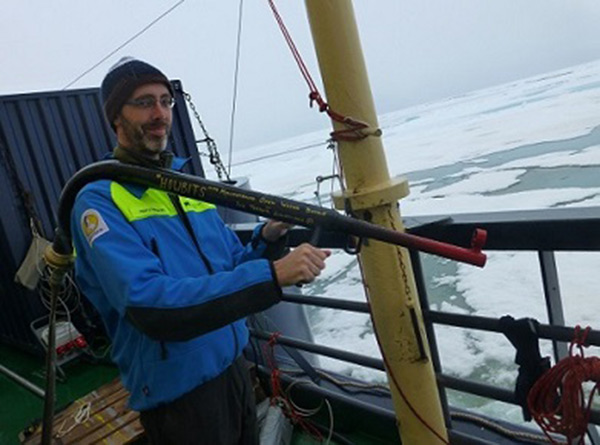|
The last day before we reach the first station (we are a bit behind schedule due to thick ice in the last days) – now it is getting really busy! Our team spent most of the last two days in the main lab, working on final preparations and solving some small technical problems. We are just leaving the lab for the meals – amazing how quickly it shifts from lunch to dinner – or for short “polar bear breaks.” In the last two days we have seen polar bears twice, and by now the phone alert is working quite well: whoever sees a bear (or some other interesting animal), calls people in the major labs. As we are not at a station yet, a short break is welcome: everybody jumps out, watches and takes pictures. The day before yesterday, we even saw one of them eating something (probably a seal)! Apart from a few curious looks at us, they didn’t seem to be disturbed.
Maybe I should say at this point a few words about “we are not a station yet.” Most of our work will take place when the ship stops (whether it is anchoring or drifting) because we have to get samples out from the water or off the sediment. However, there are also continuous measurements going on: meteorological measurements, air and surface water measurements.
We are helping each other with our measurement – for the water and sediment measurements we have to be ready to take samples at the right time when the ship stops, so all preparations have to be done in between the stations. The water and air lab are also 3 levels apart, so there is quite some running around involved. We will see how it works out once we reach the study areas! Preparation for water and sediment sampling is under control now for our team: the first set of stations is final, we have a plan for which samples to take where, our sample bottles are prepared and labelled and the sampling should work quickly and efficiently. Some last small details have also been sorted out – for example, setting up a water hose to blow away ice sheets approaching the ship during sampling. The latter has been fixed by the ship’s fitter – who has helped us a lot during this week.

With the sampling routines being clear, we have focused in the last days more on testing and optimizing the sample analysis with our gas chromatograph, to get a quick and accurate result for the methane concentration in our samples. Beside, we did a cross-calibration of the (in total four) different instruments that are used to measure methane in the water, in the air and in the sediment – this is important to make sure that we can compare the results later. We also tested our instruments for preparing the samples for the radiocarbon measurement of methane: My “stripping boards” and my colleague Celia’s “air line” both work with a similar principle: methane is captured in a cooled trap filled with a molecular absorbent that is cooled down to low temperature with liquid nitrogen or an electrical cooler. While Celia can pump the air directly through her trap, I need to get the dissolved methane in the water into gas form first. For this I keep my water sample in a large container (we use empty beerkegs as sample containers – they are made of stainless steel and contain Helium on the top or “headspace”. A ”stripping board” is connected to the sample, and this contains a circulation pump that sprays the sample with Helium, releasing the methane from the water and capturing it into the headspace. That headspace is circulated through my methane trap, where the methane gets absorbed. To get all the methane out of the water, the sample is processed for 2 hours!. This is why I have four stripping boards to process samples in parallel, especially when we get to our main area of interest in a few days (second stop).
Tomorrow we will make our first stop which will last for 2.5 days. The ship will transect the Nansen-Laptev Rise along the Gakkel ridge and the nearby canyon. The focus of these first stations is mainly on the geophysical site, studying/mapping out the canyon and also the sediment transport. For the methane group it will be a gentle start at this station as we want an idea about methane concentrations and methane’s stable isotopes along the way. However, we will keep our eyes open for interesting features; and further up the slope, we might see indications of hydrate degassing, so we will make sure to observe the geophysical features and also quickly analyze our methane concentration samples.
Off we go!
|















